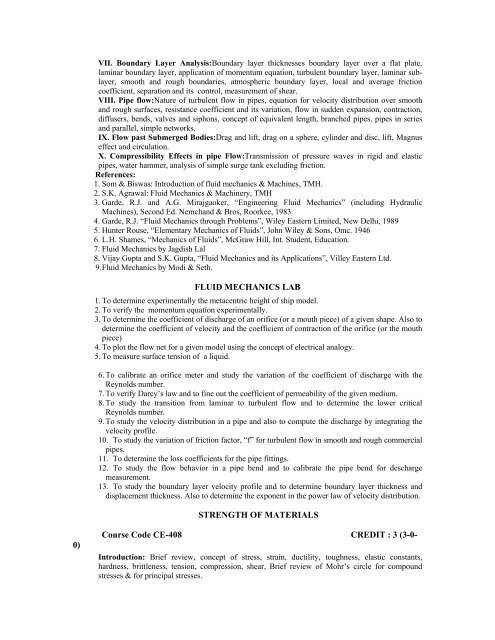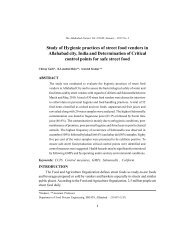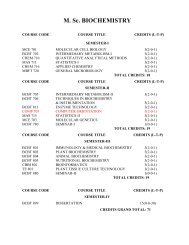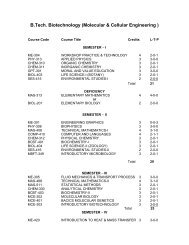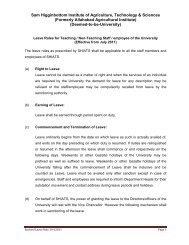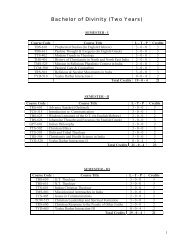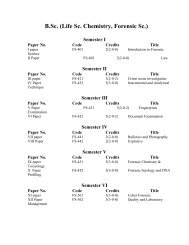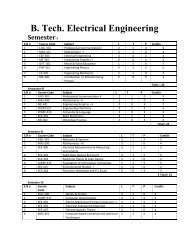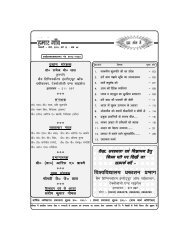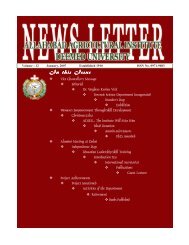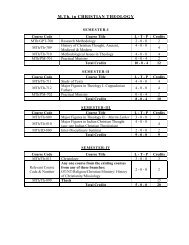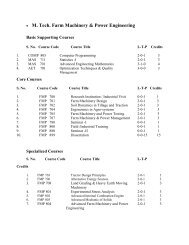VII. Boundary Layer Analysis:Boundary layer thicknesses boundary layer over a flat plate,lam<strong>in</strong>ar boundary layer, application of momentum equation, turbulent boundary layer, lam<strong>in</strong>ar sublayer,smooth and rough boundaries, atmospheric boundary layer, local and average frictioncoefficient, separation and its control, measurement of shear.VIII. Pipe flow:Nature of turbulent flow <strong>in</strong> pipes, equation for velocity distribution over smoothand rough surfaces, resistance coefficient and its variation, flow <strong>in</strong> sudden expansion, contraction,diffusers, bends, valves and siphons, concept of equivalent length, branched pipes, pipes <strong>in</strong> seriesand parallel, simple networks.IX. Flow past Submerged Bodies:Drag and lift, drag on a sphere, cyl<strong>in</strong>der and disc, lift, Magnuseffect and circulation.X. Compressibility Effects <strong>in</strong> pipe Flow:Transmission of pressure waves <strong>in</strong> rigid and elasticpipes, water hammer, analysis of simple surge tank exclud<strong>in</strong>g friction.References:1. Som & Biswas: Introduction of fluid mechanics & Mach<strong>in</strong>es, TMH.2. S.K. Agrawal: Fluid Mechanics & Mach<strong>in</strong>ery, TMH3. Garde, R.J. and A.G. Mirajgaoker, “<strong>Eng<strong>in</strong>eer<strong>in</strong>g</strong> Fluid Mechanics” (<strong>in</strong>clud<strong>in</strong>g HydraulicMach<strong>in</strong>es), Second Ed. Nemchand & Bros, Roorkee, 19834. Garde, R.J. “Fluid Mechanics through Problems”, Wiley Eastern Limited, New Delhi, 19895. Hunter Rouse, “Elementary Mechanics of Fluids”, John Wiley & Sons, Omc. 19466. L.H. Shames, “Mechanics of Fluids”, McGraw Hill, Int. Student, Education.7. Fluid Mechanics by Jagdish Lal8. Vijay Gupta and S.K. Gupta, “Fluid Mechanics and its Applications”, Villey Eastern Ltd.9. Fluid Mechanics by Modi & Seth.FLUID MECHANICS LAB1. To determ<strong>in</strong>e experimentally the metacentric height of ship model.2. To verify the momentum equation experimentally.3. To determ<strong>in</strong>e the coefficient of discharge of an orifice (or a mouth piece) of a given shape. Also todeterm<strong>in</strong>e the coefficient of velocity and the coefficient of contraction of the orifice (or the mouthpiece)4. To plot the flow net for a given model us<strong>in</strong>g the concept of electrical analogy.5. To measure surface tension of a liquid.6. To calibrate an orifice meter and study the variation of the coefficient of discharge with theReynolds number.7. To verify Darcy’s law and to f<strong>in</strong>e out the coefficient of permeability of the given medium.8. To study the transition from lam<strong>in</strong>ar to turbulent flow and to determ<strong>in</strong>e the lower criticalReynolds number.9. To study the velocity distribution <strong>in</strong> a pipe and also to compute the discharge by <strong>in</strong>tegrat<strong>in</strong>g thevelocity profile.10. To study the variation of friction factor, “f” for turbulent flow <strong>in</strong> smooth and rough commercialpipes.11. To determ<strong>in</strong>e the loss coefficients for the pipe fitt<strong>in</strong>gs.12. To study the flow behavior <strong>in</strong> a pipe bend and to calibrate the pipe bend for deschargemeasurement.13. To study the boundary layer velocity profile and to determ<strong>in</strong>e boundary layer thickness anddisplacement thickness. Also to determ<strong>in</strong>e the exponent <strong>in</strong> the power law of velocity distribution.STRENGTH OF MATERIALS0)Course Code CE-408 CREDIT : 3 (3-0-Introduction: Brief review, concept of stress, stra<strong>in</strong>, ductility, toughness, elastic constants,hardness, brittleness, tension, compression, shear, Brief review of Mohr’s circle for compoundstresses & for pr<strong>in</strong>cipal stresses.
Theories of Failure:Various theories of failure and its comparison.Review of Bend<strong>in</strong>g and Torsion:Brief review of bend<strong>in</strong>g of beams and shear force & bend<strong>in</strong>gmoment diagram. Review of torsion of circular shaft and comb<strong>in</strong>ed bend<strong>in</strong>g & torsion. Shear<strong>in</strong>gstresses <strong>in</strong> beams section.Deflection of Beams: Deflection of beams, Integration method, Macaulay’s method, Area momentmethod, Unit load method.Columns and Struts: Theory of columns & Struts, Eulers and Rank<strong>in</strong>e formulae.Th<strong>in</strong> Cyl<strong>in</strong>ders: Theory of th<strong>in</strong> cyl<strong>in</strong>ders subjected to pressure. Expression for hoop stress andlongitud<strong>in</strong>al stress. Design of th<strong>in</strong> cyl<strong>in</strong>ders.Thick Cyl<strong>in</strong>ders and Spherical Shells:Stresses and stra<strong>in</strong> <strong>in</strong> thick shells/cyl<strong>in</strong>der subjected topressures. Compound cyl<strong>in</strong>ders press fits on solid shaft.Fracture, Fatique and Creep:Stress concentration, Grifith’s formula. Fatigue load<strong>in</strong>g, endurancelimit, Creep.References:1. Strength of Materials by Ryder2. Strength of Materials by S<strong>in</strong>ger3. Strength of Materials by Oimoshenko4. Engg. Mechanics of Solids by Popov5. Mechanics of Materials by Bear Johnson6. Strength of Materials by R.K. Rajput7. Strength of Materials by Ramamrutham & Nara<strong>in</strong>.MATERIAL SCIENCE & TESTINGCourse Code ME-410 CREDIT :4(3-0-1)In troduction: Historical perspective, importance of materials, Brief review of modern & atomicconcepts <strong>in</strong> Physics and Chemistry. Atomic models, Periodic table, Chemical bond<strong>in</strong>gs.Crystallography and Imperfections: Concept of unit cell space lattice, Bravais lattices, commoncrystal structures, Atomic pack<strong>in</strong>g factor and density. Miller <strong>in</strong>dices. X-ray crystallography techniques.Imperfections, Defects & Dislocations <strong>in</strong> solids.Mechanical Properties and Test<strong>in</strong>g: Stress stra<strong>in</strong> diagram, Ductile & brittle material, Stress VsStrength. Toughness, Hardness, Fracture, Fatigue and Creep. Test<strong>in</strong>g such as Strength test<strong>in</strong>gs,Hardness test<strong>in</strong>g, Impact test<strong>in</strong>gs, Fatigue Test<strong>in</strong>g Creep test<strong>in</strong>g, Non-destructive test<strong>in</strong>g (NDT)Microstructural Exam: Microscope pr<strong>in</strong>ciple and methods. Preparation of samples and microstructureexam and gra<strong>in</strong> size determ<strong>in</strong>ation. Comparative study of microstructure of various metals & alloyssuch as Mild steel, CI, Brass.Phase Diagram and Equilibrium Diagram: Unitary and B<strong>in</strong>ary diagrams, Phase rules, Types ofequilibrium diagrams: Solid solution type, eutectic type and comb<strong>in</strong>ation type. Iron-carbon equilibriumdiagram.Ferrous Materials: Iron and steel manufacture, furnaces. Various types of carbon steels alloy steelsand cast irons, its properties and uses.Heat Treatment: Various types of heat treatment such as Anneal<strong>in</strong>g, Normaliz<strong>in</strong>g Quench<strong>in</strong>g,Temper<strong>in</strong>g and case harden<strong>in</strong>g. Time Temperature Transformation (TTT) diagrams.Non-Ferrous metals and alloys:Non-ferrous metals such as Cu, Al, Zn, Cr, Ni, etc. and itsapplications. Various type Brass, Bronze, bear<strong>in</strong>g materials, its properties and uses. Alum<strong>in</strong>um alloyssuch as Duralum<strong>in</strong>. Other advanced materials/alloys.Magnetic Properties: Concept of magnetism-Dia, para, ferro Hysteresis. Soft and har magneticstorages.Electric Properties: Energy ban concept of conductor, <strong>in</strong>sulator and semiconductor. Intr<strong>in</strong>sic &extr<strong>in</strong>sic semi-conductors, P-n junction and transistors. Basic devices and its application. Superconductivity and its applications. Messier effect. Type I & II Superconductors. High TeSuperconductors.
- Page 1 and 2: B. Tech. Production & IndustrialEng
- Page 3 and 4: 6 ME 516 Energy Management 3‐1‐
- Page 5 and 6: Sin, orign of sin, manifestation of
- Page 7 and 8: Center of gravity, centroids of lin
- Page 9 and 10: 2. To determine the Ferrous content
- Page 11 and 12: 6. Study of Scientific and General
- Page 13 and 14: 6. X-Rays: Origin of X-rays, Contin
- Page 15 and 16: 11. Write C program to demonstrate
- Page 17: Steam Turbines: Classification, imp
- Page 21 and 22: Environment Protection act.Air (Pre
- Page 23 and 24: Transformers:Construction, EMF equa
- Page 25 and 26: 5. Production Planning and Control:
- Page 27 and 28: Interpolation:Introduction, Errors
- Page 29 and 30: Note-1. Students may be advised to
- Page 31 and 32: Mental blocks, Removal blocks, Idea
- Page 33 and 34: Carburetion and gasoline Injection:
- Page 35 and 36: With initial review teaching of Aut
- Page 37 and 38: 2. Conventional energy resources an
- Page 39 and 40: Array, matrix, string, structure, c
- Page 41 and 42: Generals requirements, Road, tyre a
- Page 43 and 44: INTRODUCTION : Past , Present and f
- Page 45 and 46: Study of the design aspects. Fluid
- Page 47: MECHANICAL VIBRATIONCourse Code ME-


